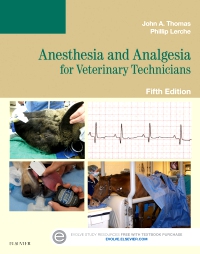
Anesthesia and Analgesia for Veterinary Technicians, 5th Edition
Paperback

Covering essential principles of anesthesia administration and pain management in small and large animals, Anesthesia and Analgesia for Veterinary Technicians, 5th Edition is completely updated with the latest drugs and techniques. This entry-level practical resource prepares your veterinary technician students to properly administer anesthesia with the most up-to-date information on pre-anesthetic preparation of the patient, induction procedures, monitoring animals’ vital signs during the anesthetic period, and postoperative care. Engage students with discussions of actions and side effects of anesthetic agents; the physiology of respiration, heart rate, and blood pressure; emergency response; anesthetic equipment; and specialized techniques — and encourage them to take a more integrated approach to learning techniques for anesthesia administration with the text’s expertly illustrated step-by-step procedures.
Newer Edition Available
-
- NEW! Updated drug information, equipment, and techniques keep students up-to-date on the latest advances in the field.
- NEW! Content on camelid anesthesia prepares students to properly treat llamas and alpacas.
- Comprehensive coverage of lab animals and large and small animals makes this an excellent resource for veterinary students and technicians.
- Two large animal anesthesia chapters cover pain management and anesthetic techniques for equine, ruminant, camelid, and swine patients.
- Procedures boxes offer clear step-by-step guidelines, with sequential, high-quality color photos, for performing common procedures during each phase of an anesthetic event.
- Reference tables and boxes facilitate rapid access to information like fluid administration rates, properties of anesthetic drugs, oxygen flow rates, anesthetic protocols, and normal and abnormal monitoring parameters.
- Vet Tech Threads help students grasp key content and include pedagogical aids, such as: introductions, suggested readings, boxed Technician Notes, learning objectives, chapter outlines, key terms, and a glossary.
- Glossary at the end of the text provides students with accurate, concise definitions.
- Evolve site provides students with additional interactive assets that reinforce what they learn in the text.
-
- NEW! Updated drug information, equipment, and techniques keep you up-to-date on the latest advances in the field.
- NEW! Content on camelid anesthesia prepares you to properly treat llamas and alpacas.
-
1. Introduction to Anesthesia 2. Patient Preparation 3. Anesthetic Agents and Adjuncts 4. Anesthetic Equipment 5. Workplace Safety 6. Anesthetic Monitoring 7. Special Techniques 8. Analgesia 9. Canine and Feline Anesthesia 10. Equine Anesthesia 11. Anesthesia of Ruminants, Camelids, and Swine 12. Rodent and Rabbit Anesthesia 13. Anesthetic Problems and Emergencies Appendices
- Appendix A: Barbiturates
- Appendix B: Halothane
- Appendix C: Nitrous Oxide
- Appendix D: Use of Nonprecision Vaporizers
- Appendix E: Procedure for Operation of a Closed Rebreathing System
- Appendix F: American College of Veterinary Anesthesia and Analgesia Monitoring Guidelines Update, 2009
- Appendix G: Equipment and Drugs for Use in an Emergency Crash Kit
- Appendix H: Standard Volumes, Weights, Measures, and Equivalents
Answer Key Glossary Index

